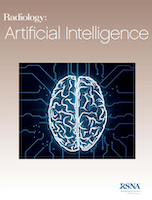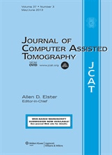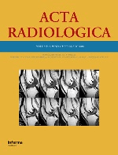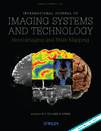
Radiology-Artificial Intelligence
Scope & Guideline
Pioneering the Future of Radiology with AI Insights
Introduction
Aims and Scopes
- Application of AI in Radiology:
The journal emphasizes the integration of artificial intelligence techniques in radiology, covering various applications such as image interpretation, segmentation, and risk prediction across diverse imaging modalities. - Deep Learning Methodologies:
A consistent focus on deep learning algorithms, especially in the context of enhancing image analysis, automating detection tasks, and improving diagnostic accuracy in radiological assessments. - Radiomics and Quantitative Imaging:
Exploration of radiomics, particularly the extraction of quantitative features from medical images, to assess tumor characteristics and predict clinical outcomes. - Interdisciplinary Approaches:
Encouragement of interdisciplinary research that combines insights from radiology, computer science, and statistics to develop robust AI models for clinical applications. - Ethical and Regulatory Considerations:
Discussion of the ethical implications and regulatory challenges associated with implementing AI technologies in clinical radiology, aiming to ensure safe and effective use.
Trending and Emerging
- Integration of AI with Clinical Workflow:
Recent publications emphasize the integration of AI tools into clinical workflows, exploring how AI can assist radiologists in decision-making, thereby improving efficiency and diagnostic accuracy. - AI for Predictive Analytics:
There is a rising trend towards using AI for predictive analytics in radiology, particularly in predicting patient outcomes and disease progression based on imaging data. - Ethics and Bias Mitigation in AI:
An increasing number of studies are addressing the ethical considerations and potential biases in AI algorithms, reflecting a growing awareness of the need for fairness and accountability in AI applications. - Collaborative AI Systems:
Emerging research focuses on collaborative systems where AI and radiologists work together, enhancing diagnostic processes while minimizing the risk of errors and improving patient care. - AI in Global Health:
The journal is seeing a trend towards exploring AI applications in global health contexts, addressing disparities in healthcare access and the role of AI in improving diagnostic capabilities in underserved populations.
Declining or Waning
- Traditional Imaging Techniques:
There is a noticeable decrease in emphasis on traditional imaging techniques without AI enhancement, as the field gravitates towards advanced AI-driven methodologies that offer greater diagnostic utility. - Basic Image Processing Techniques:
Papers focusing solely on basic image processing without incorporation of advanced AI methods are becoming less frequent, indicating a shift towards more sophisticated, AI-integrated approaches. - General Reviews of AI in Radiology:
The journal has moved away from broad reviews of AI applications in radiology, favoring more specific studies that demonstrate clear clinical applications and outcomes. - Single-Modal AI Applications:
There is a waning interest in AI applications that focus on single imaging modalities, as researchers increasingly seek multi-modal approaches that leverage data from various imaging sources for improved accuracy and insights.
Similar Journals

EUROPEAN RADIOLOGY
Advancing the Frontiers of Medical ImagingEUROPEAN RADIOLOGY, published by SPRINGER, stands as a prestigious international journal in the field of radiology, nuclear medicine, and imaging, with an impressive impact factor that underscores its significance among peers. With an ISSN of 0938-7994 and an E-ISSN of 1432-1084, this journal provides a platform for cutting-edge research and advancements in medical imaging from 1991 to 2024. Recognized as a Q1 journal in both general Medicine and the specialized Radiology category by 2023, EUROPEAN RADIOLOGY ranks an impressive #17 out of 333 in its field according to Scopus, placing it in the 95th percentile. While it does not currently offer Open Access options, the journal remains essential reading for researchers, professionals, and students striving to stay at the forefront of developments in diagnostic imaging and related technologies. By contributing to a comprehensive understanding of radiological practices, EUROPEAN RADIOLOGY plays a crucial role in shaping the future of medical diagnosis and patient care.

JOURNAL OF COMPUTER ASSISTED TOMOGRAPHY
Advancing Diagnostic Imaging through InnovationJOURNAL OF COMPUTER ASSISTED TOMOGRAPHY, published by Lippincott Williams & Wilkins, stands as a vital resource in the field of Radiology, Nuclear Medicine, and Imaging. Since its inception in 1977, this journal has been dedicated to advancing the understanding and application of computer-assisted tomography, emphasizing innovative research and clinical practices that enhance diagnostic imaging techniques. With an impact factor reflective of its rigorous scholarship and relevance—ranking in the Q3 category—the journal serves as an essential platform for contributors and readers alike, navigating the challenges and opportunities within a rapidly evolving field. Researchers, professionals, and students are encouraged to engage with the rich repository of articles that cover emerging technologies, clinical applications, and theoretical advancements, collectively fostering a deeper comprehension of imaging sciences. Although not currently designated as an open-access journal, it continues to enhance discourse in the community from its headquarters in Philadelphia, PA, maintaining a commitment to the highest standards of academic excellence.

ACTA RADIOLOGICA
Pioneering Insights in Radiology and Imaging TechnologyACTA RADIOLOGICA, published by SAGE Publications Ltd, is a premier journal dedicated to the evolving field of radiology, bridging the gap between clinical practice and research from its inception in 1921 to its anticipated continuation until 2024. With an ISSN of 0284-1851 and an E-ISSN of 1600-0455, this esteemed journal holds a significant position in the academic landscape, reflected in its 2023 rankings as Q3 in several categories, including Medicine (miscellaneous), Radiological and Ultrasound Technology, and Radiology, Nuclear Medicine and Imaging. Although currently not an open-access journal, ACTA RADIOLOGICA offers robust subscription options allowing a wide readership among researchers, healthcare professionals, and students striving to stay at the forefront of radiological advancements. The journal publishes original research, reviews, and clinical studies that contribute to the understanding and application of imaging technologies, underscoring its vital role in shaping modern medical practices.

INTERNATIONAL JOURNAL OF IMAGING SYSTEMS AND TECHNOLOGY
Innovating the Landscape of Imaging SystemsINTERNATIONAL JOURNAL OF IMAGING SYSTEMS AND TECHNOLOGY, published by Wiley, is a leading journal dedicated to advancing the field of imaging systems and technologies. With an ISSN of 0899-9457 and E-ISSN 1098-1098, this esteemed journal offers a platform for high-quality research spanning essential interdisciplinary areas, including Biomedical Engineering, Computer Science, and Health Informatics. Recognized for its impactful contributions, it holds a commendable position in the Q2 quartile across multiple categories as of 2023. The journal boasts an excellent Scopus ranking, with notable acknowledgments like rank #49 out of 333 in Radiology, Nuclear Medicine, and Imaging, showcasing its relevance and importance in the academic community. Publishes annually from 1989 to 2024, it aims to bridge gaps in knowledge and foster innovative developments through rigorous peer-reviewed articles. Though it operates under a traditional access model, the journal maintains an accessible repository of cutting-edge research, making it indispensable for researchers, professionals, and students alike seeking to stay at the forefront of imaging technology advancements.

JOURNAL OF DIGITAL IMAGING
Transforming Insights into Digital Imaging ExcellenceJOURNAL OF DIGITAL IMAGING, published by Springer, is a premier journal dedicated to the field of digital imaging, encompassing significant developments in the intersecting disciplines of radiology, computer science applications, and ultrasound technology. With its impressive Q1 ranking in the categories of Radiology, Nuclear Medicine and Imaging, and Radiological and Ultrasound Technology, and a substantial Q2 ranking in Computer Science Applications, this journal is positioned at the forefront of research dissemination in these vital areas. The ISSN 0897-1889 and E-ISSN 1618-727X signify its broad reach and accessibility, while its Scopus rankings demonstrate its robust impact in the academic community, ranked #41/333 in Radiology and earning a notable 87th percentile status. Since its inception in 1988, the journal has served as a vital resource for researchers and professionals seeking to advance their understanding of digital imaging technologies and their applications. Although it does not currently offer open access options, it continues to foster scholarly dialogue and innovation, making it an indispensable platform for those committed to excellence in imaging science and technology.

Current Medical Imaging
Unveiling the Future of Imaging in MedicineCurrent Medical Imaging is a reputable journal published by Bentham Science Publishers, specializing in the dynamic field of medical imaging, with a strong emphasis on both clinical applications and technological advancements. Established in 2007, the journal has made significant contributions to the fields of Internal Medicine and Radiology, consistently ranking in the Q3 quartile for these categories as of 2023. The journal's ISSN 1573-4056 and E-ISSN 1875-6603 ensure wide accessibility for scholarly communication, although it operates under a traditional access model. With its continuous publication from 2011 to 2024, Current Medical Imaging aims to bridge the gap between advanced imaging techniques and their practical application in patient care, making it indispensable for researchers, healthcare professionals, and students eager to stay at the forefront of innovations in imaging technology and clinical practice.

Contemporary Diagnostic Radiology
Innovative Insights in Diagnostic RadiologyContemporary Diagnostic Radiology is a pivotal journal in the field of medical imaging and radiology, published by Lippincott Williams & Wilkins. With an ISSN of 0149-9009 and an E-ISSN of 1938-1395, this journal serves as an essential platform for disseminating high-quality research and advances in diagnostic radiology and related disciplines. While it is categorized in the lower quartiles (Q4) for its performance in the 2023 rankings in both Neurology, Radiology, Nuclear Medicine and Imaging, and Surgery, its focus on emerging technologies and methodologies in imaging continues to provide valuable insights for practitioners and researchers alike. The journal’s scope includes innovative diagnostic tools, imaging techniques, and case studies, fostering collaboration and knowledge sharing in the medical community. Although it does not offer open access options, its commitment to contributing to the ongoing dialogue in clinical imaging is undisputed, making it an essential resource for professionals seeking to stay abreast of current trends and research in the rapidly evolving landscape of diagnostic radiology.

Diagnostic and Interventional Radiology
Pioneering Insights in Diagnostic and Interventional TechniquesDiagnostic and Interventional Radiology, published by the Turkish Society of Radiology, is a renowned open-access journal dedicated to advancing the fields of radiology, nuclear medicine, and imaging. With its transition to open access in 2022, the journal aims to foster knowledge dissemination and accessibility for researchers, healthcare professionals, and students alike. This esteemed publication, indexed in Scopus, features a robust editorial board and peer-reviewed articles that contribute significantly to the body of work in cardiology, radiology, and related disciplines. The journal currently holds a significant position, reflected in its Category Quartiles ranking—Q2 in Radiology, Nuclear Medicine, and Imaging, and Q3 in Cardiology and Cardiovascular Medicine, highlighting its relevance and impact in these critical medical fields. Research published in this journal is vital for evolving diagnostic and interventional techniques, clearly situating it as a key resource for those seeking to stay at the forefront of radiological science.

Chinese Journal of Academic Radiology
Pioneering Insights in Imaging and Patient CareChinese Journal of Academic Radiology is a leading publication in the field of Radiology, Nuclear Medicine, and Imaging, published by SpringerNature. With an ISSN of 2520-8985 and E-ISSN 2520-8993, the journal aims to bridge the gap between academic research and practical application in radiological sciences. Recognized for its contributions to the advancement of imaging technology and patient care, it currently holds a Q3 quartile ranking for 2023. The journal has a commitment to sharing innovative research findings that address pressing challenges in the field, thereby fostering collaboration and knowledge exchange among researchers, professionals, and students. Although it does not currently offer open access options, the journal's comprehensive reviews and high-quality research articles present a significant resource for those seeking to deepen their understanding of radiological practices and innovations. The Chinese Journal of Academic Radiology continues to play a vital role in shaping the future of radiological science through rigorous scholarship and global discourse.

ROFO-FORTSCHRITTE AUF DEM GEBIET DER RONTGENSTRAHLEN UND DER BILDGEBENDEN VERFAHREN
Exploring Breakthroughs in Radiology and Nuclear MedicineROFO-Fortschritte auf dem Gebiet der Röntgenstrahlen und der bildgebenden Verfahren, published by Georg Thieme Verlag KG, is a pivotal journal in the fields of radiology and nuclear medicine, offering invaluable insights for researchers, healthcare professionals, and students alike. With an ISSN of 1438-9029, this journal has been a stalwart of scientific communication since its inception in 1975, actively contributing to advancements in imaging techniques and radiation therapy. Although it operates under traditional access, the journal maintains a respectable standing, reflected by its Q3 ranking in Radiology, Nuclear Medicine and Imaging and Q4 in Medicine (miscellaneous), highlighting its significance in the scholarly community. Its coverage spans a wide array of topics pertinent to diagnostic imaging and therapy protocols, making it an essential resource for anyone seeking to understand the complexities of modern radiological practices. As the journal continues to evolve through 2024, it invites contributions that enrich the dialogue around technological innovations and clinical applications in the realm of imaging modalities.